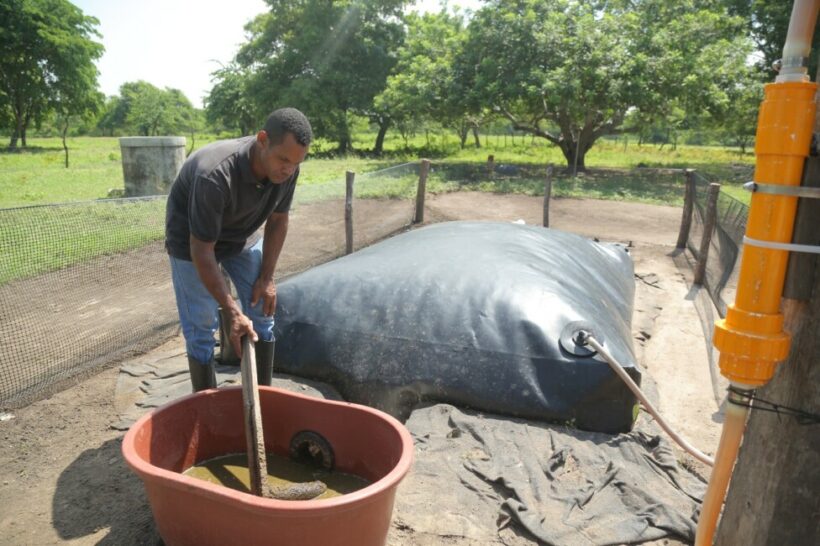Elkin Palacin wakes up at three in the morning every day. His work is milking the cows and rotating the cattle on the small 20-hectare El Triunfo farm in the rural municipality of Ponedera, in the southern department of Atlántico, in the far north of Colombia.
But for about a year his morning routine has changed. Before, he had to fetch firewood, light a rustic cooker and prepare his coffee, the first food he drinks every day. Right there, on that rudimentary cooker fuelled by pieces of trees cut on the farm, his wife cooked breakfast, lunches and dinners every day. But now, neither he nor his wife use it.
The same thing happened to Guido Rivera, another farmer and farm manager in Manatí, in the same department. For him, the option was to cut wood or buy a methane gas cylinder, a purchase that could cost him an average of 120,000 pesos a month, about 29 dollars.
But now, neither of them use cookers or pay for gas cylinders. And although connection to natural gas is not yet a reality due to the remoteness of the farms (although it could happen in the future), what is certain is that it is enough to turn the knob, turn on the flame and put the pot on the cooker to start cooking, thanks to the installation of biodigesters on their farms.
Both farmers, who work on farms that are part of the Association of Small Livestock Producers, were beneficiaries of a project promoted by the Regional Autonomous Corporation of the Atlantic (CRA).
The initiative integrates agro-environmental models, energy efficiency alternatives and environmental education to reduce the extraction of firewood and charcoal in these two municipalities in southern Atlántico, whose departmental capital is the city of Barranquilla.
The idea is simple: through a biodigester, cow dung is used to generate methane gas, a key biofuel for the energy transition, because if it is burned efficiently, it can produce energy with low emissions, but also because it can be used to generate fertilisers or electricity.
In Colombia, gas also faces major challenges in the region.
The Colombian Association of Large Industrial and Commercial Energy Consumers (Asoenergía) said that since 8 August, companies in the Caribbean region have had almost a month with restrictions on the supply of natural gas for their operations.
The origin is the difficulties that are registering some production wells and equipment of Canacol Energy.
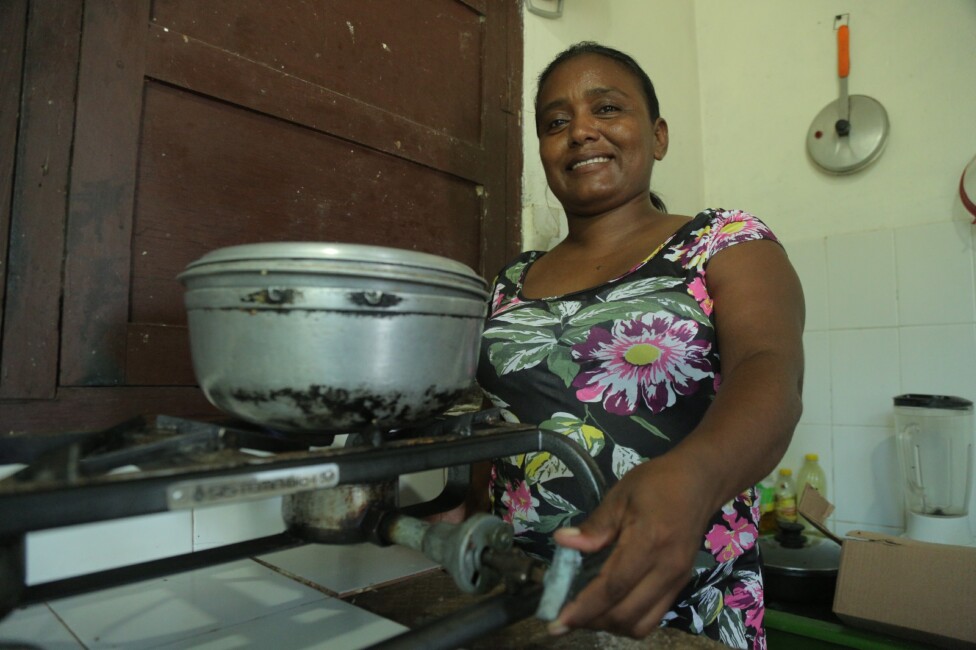
Elkin Palacin’s wife, in front of the cooker they now use, which is powered by the biogas produced by the biodigester they now have on their farm and which facilitates the couple’s daily routines. Image: CRA
According to the director of the CRA, Jesús León Insignares, although these biodigesters were installed about 8 months ago, the project started a few years ago when they began to develop actions of the Institutional Action Plan (PAI) of the corporation.
The objective of this plan is to reduce deforestation figures in a department where 70% of the farms have a livestock or agricultural vocation. This, while generating access to renewable energy in rural areas.
“These biodigesters have been installed in some rural farms in the department and in schools, which we have called Ecoescuelas, seeking multiple objectives. Among them is the avoidance of deforestation as the main objective, Insignares points out.
It is also a strategy, he adds, “to replace these deep-rooted customs of using charcoal or firewood, where to obtain these materials, illegal exploitation is carried out to gather the materials needed for cooking”.
“Today, with the development of these projects, this has been replaced by these biodigesters, which also represent an adaptation to climate change,” he explains.
The official emphasises that the results of this first stage of the project, in which three biodigesters were installed in Manatí and three in Ponedera, have been so positive that the idea is to take the initiative from the south of the department to the north, to coastal municipalities such as Juan de Acosta, where there is also a large number of cattle farms, but where the loss of standing forest and desertification has been greater in the agricultural scenario.
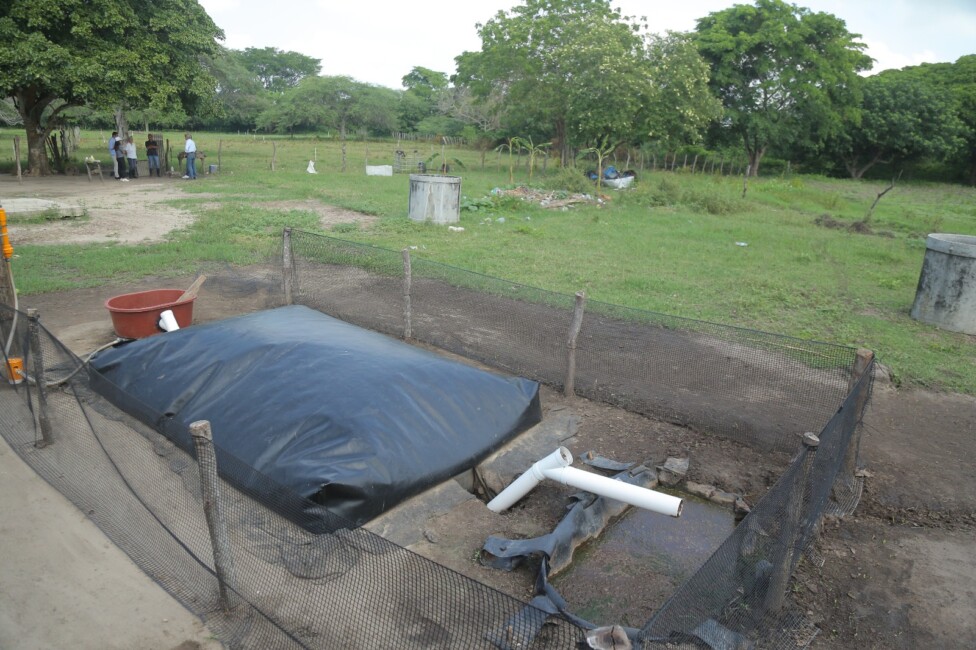 The biodigesters installed on farms such as Elkin Palacin’s are simple technology and easy to operate and maintain. Colombia is a country where different biodigestion systems have not been developed. Image: CRA
The biodigesters installed on farms such as Elkin Palacin’s are simple technology and easy to operate and maintain. Colombia is a country where different biodigestion systems have not been developed. Image: CRA
“This project has been so wonderful that it motivates us to continue and replicate it,” he argues.
The idea, he adds, “is that this can be part of our Action Plan to reach each of the municipalities and increase the number of beneficiaries in the department of Atlántico”.
“Why aren’t there more projects like this in the country if the results are so positive? Perhaps because of a lack of knowledge and we hope that this will be a model to replicate. These are strategies where science, technology, innovation and even nature-based solutions themselves generate positive impacts,” adds the director.
The impact, although the project is small, has not been small.
According to the CRA’s own calculations, each biodigester avoids the felling of 106 trees, which is equivalent to not deforesting one hectare of forest. That is, if we take into account that on average a medium-sized Trupillo tree produces eight charges of firewood (80 kilos per charge).
In other words, with the installation of these six biodigesters, the Atlantic is saving six hectares of standing forest.
In addition, there is a reduction in gas emissions, explains Luz Stella Murgas, president of the Colombian Association of Natural Gas (Naturgas).
Firewood, she explains, generates a dark-coloured smoke in the burning process, which is composed of a complex mixture of gases and fine particles, the so-called particulate matter, which in its finer structure (PM 2.5 and below) generates serious public health effects.
In contrast, biogas combustion has a similar impact to natural gas, which can reduce these fine particulate matter emissions by up to 99.9 %, which is why black smoke is not observed when it is burned.
“Natural gas is eminently methane, however, when it burns, its chemical composition changes, generating small emissions of CO2 and water mostly,” says Murgas.
The difference between the two is that natural gas is a fossil fuel that contributes to the climate crisis, while biogas is generated from the decomposition of organic matter and consists mainly of methane and carbon dioxide, so the efficient collection and processing of such matter could promote the protection of the atmosphere, provided the process is properly controlled.
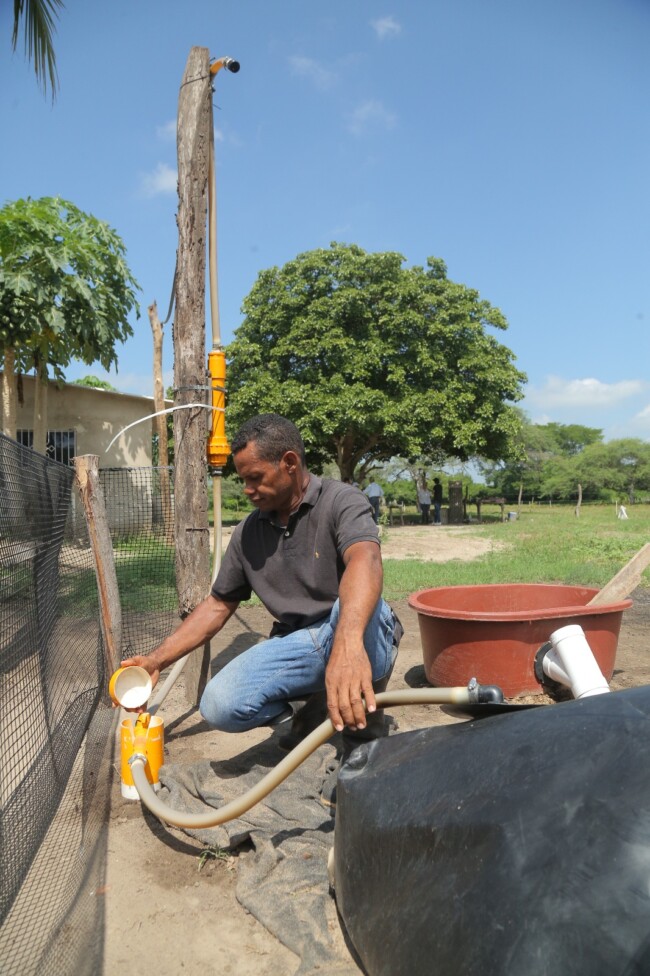
Elkin Palacin checks the biodigester, which requires little care and almost no maintenance, every day. Image: CRA
How does a biodigester work?
A biodigester essentially consists of a fermentation chamber (which can be a plastic geomembrane, a tank or an underground chamber) where manure (which can be from any animal) and organic matter are kept in the absence of oxygen and create favourable conditions for the growth of consortia of microorganisms essential for the formation of methane gas.
There are three types of biodigesters in the world: fixed dome, floating hood or continuous flow (the one mostly used in the country) and they work in a very similar way.
Once the gas is produced, which is stored inside the chamber itself, it is extracted and used either to generate thermal energy (for cookers such as cookers) or electrical energy, through the burning of the biogas itself.
In addition, biodigesters also produce a liquid fertiliser that can be used to fertilise farms and even for aquaculture, as some of the CRA’s projects do.
According to Martín Atencio, from the company Consultores y Asesores Agropecuarios (COA), the operation is very simple for the farms that have benefited from these systems.
This is because all Guido and Elkin have to do is “feed” the device in the mornings or afternoons with manure and wait a couple of hours for the biodigester bag (which is the chamber where the anaerobic process takes place) to start generating gas and fertiliser in a natural way.
COA, which was the project executing company for the implementation of these first six biodigesters in the Atlantic, encountered several obstacles along the way.
Among them, Atencio points out that this technology, which is very popular in Asia, is little known and commercialised in the Colombian market. In fact, for these devices, an order had to be placed with a company located in the city of Medellín, which is one of the few that manufactures them in Colombia and which took several months to deliver.
“The biodigester is expensive. That is why it is not promoted more. But it is also unknown. One is surprised that productive farms, with large numbers of livestock, do not make an investment of 15 or 20 million pesos (between 3900 and 5100 dollars),” says Atencio.
This one we use in the Atlantic is eight cubic metres, one of the largest available. But you can have any size you want. If you have the capacity to produce manure to fill a 12 to 16 cubic metre bag, you can.
“Why doesn’t a big farmer have something like this? You have to take advantage of these technological innovations, why this has a very quick return on investment,” he says.
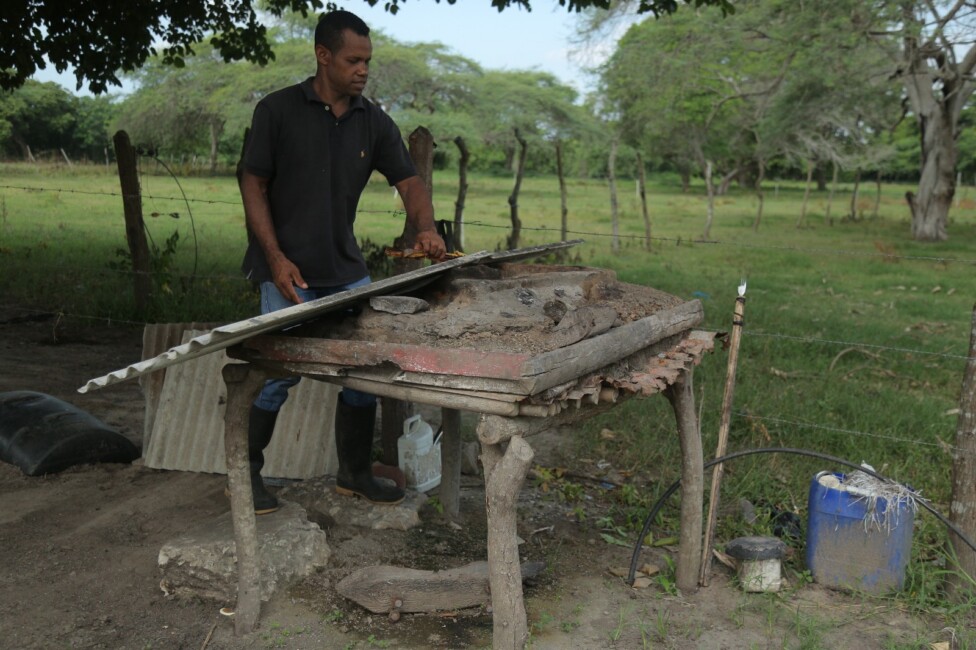 Mounted on some logs is still the old wood cooker that Elkin Palacin and his wife used to cook on a daily basis and which they have now replaced with a cooker powered by the biogas generated by their biodigester. Image: CRA
Mounted on some logs is still the old wood cooker that Elkin Palacin and his wife used to cook on a daily basis and which they have now replaced with a cooker powered by the biogas generated by their biodigester. Image: CRA
A key energy source
Biodigesters are not new. In Asia, they have been used for hundreds of years in rural areas for the production of biogas from manure and other agricultural waste.
In fact, according to data from the International Institute for Environment and Development, during the 1970s, the Chinese government installed more than seven million biodigesters in rural households to meet the energy needs of its population.
By 2007, most of the nearly 27 million biogas plants that had been installed worldwide were in China, and by 2010, with the construction of five million new units, it is estimated that China reached a total of 40 million biodigesters installed.
In Latin America, according to a study published in the journal Renewable and Sustainable Energy Reviews entitled ‘Domestic anaerobic digesters for biogas production in Latin America: A review’, several reasons for their low use are highlighted.
It points out that the high availability of wood as fuel in rural areas, the need for technical improvements, the lack of social acceptance and the high investment costs for their implementation are the main limitations currently facing biodigesters in the region.
For Atencio, the future of energy in rural areas does not only lie in solar panels or windmills, but also in biodigesters. This is why their maintenance is simple, their construction is easy and when they become widespread, their installation cost can be considerably reduced, as is the case in Asia.
Biodigesters can run for decades, require little maintenance and are easy to operate. Basically, as long as there is organic waste, gas can be produced, an energy source that has also faced high volatility in recent years in the country.
“We are latecomers to this technology, but it is already widely used around the world. Especially in China, where it is used at levels that one cannot imagine. In China, they don’t talk about sewage in schools, hospitals, prisons or battalions,” Atencio points out.
He adds that “there is no dumping of black water there, what they have are biodigesters in the basements that generate energy for the buildings”.
“When are we going to get to that? Why does it produce energy? It’s like a thermoelectric plant that uses gas instead of coal,” she asks herself.
The truth is that, for now, projects related to the promotion of biodigesters for energy generation in the country are still few and far between and can easily be counted on one’s hands. For this article, the Colombian Ministry of Energy was consulted if the use of biodigesters will be promoted in the current government, but despite repeated requests, no response was received.
On the other hand, the project that perhaps made the most progress in this direction was one promoted by Porkcolombia, which aims to have pig farms in the country using these systems by 2020.
For this reason, they have supported projects for the construction of these systems in various departments of the country, together with regional autonomous corporations such as Carder, Corpocaldas and the Huila Regional Autonomous Corporation (CAM).
In addition, in the department of Valle del Cauca, in the east of the country, they directed a diploma course in biodigestion in collaboration with the Universidad del Valle, the Universidad Nacional de Palmira and the Universidad Icesi.
“Every day more and more farms are implementing this type of technology because of its benefits in methane generation, as it helps to mitigate greenhouse gas emissions and allows the substitution of natural gas or electricity, which reduces costs in the production process,” says Corina Zambrano, executive vice-president of Porkcolombia.
If these devices can be an essential element, according to experts, in the energy transition, and play a role as relevant as solar panels or windmills, today Colombia is still lagging behind and projects are still few and far between.
“The biodigester improved the quality of life for me and my wife. In winter time we had to go out here, with wet firewood, and it was a nightmare. Today we don’t leave the house to cook and we have gas available at any time”, says farmer Elkin.
This article was produced with the special support of Climate Tracker América Latina and Open Society Foundations.
VR: EG


